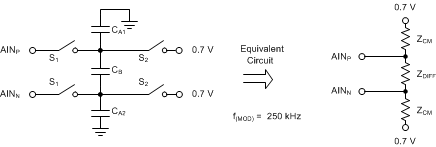JAJSHX4D November 2012 – September 2019 ADS1018
PRODUCTION DATA.
- 1 特長
- 2 アプリケーション
- 3 概要
- 4 改訂履歴
- 5 概要(続き)
- 6 Device Comparison Table
- 7 Pin Configuration and Functions
- 8 Specifications
- 9 Detailed Description
- 10Application and Implementation
- 11Power Supply Recommendations
- 12Layout
- 13デバイスおよびドキュメントのサポート
- 14メカニカル、パッケージ、および注文情報
パッケージ・オプション
メカニカル・データ(パッケージ|ピン)
サーマルパッド・メカニカル・データ
発注情報
9.3.2 Analog Inputs
The ADS1018 uses a switched-capacitor input stage where capacitors are continuously charged and then discharged to measure the voltage between AINP and AINN. This frequency at which the input signal is sampled is called the sampling frequency or the modulator frequency (f(MOD)). The ADS1018 has a 1-MHz internal oscillator which is further divided by a factor of 4 to generate the modulator frequency at 250 kHz. The capacitors used in this input stage are small, and to external circuitry, the average loading appears resistive. This structure is shown in Figure 9. The resistance is set by the capacitor values and the rate at which they are switched. Figure 10 shows the setting of the switches illustrated in Figure 9. During the sampling phase, switches S1 are closed. This event charges CA1 to V(AINP), CA2 to V(AINN), and CB to (V(AINP) – V(AINN)). During the discharge phase, S1 is first opened and then S2 is closed. Both CA1 and CA2 then discharge to approximately 0.7 V and CB discharges to 0 V. This charging draws a very small transient current from the source driving the ADS1018 analog inputs. The average value of this current can be used to calculate the effective impedance (Zeff), where Zeff = VIN / IAVERAGE.
 Figure 9. Simplified Analog Input Circuit
Figure 9. Simplified Analog Input Circuit  Figure 10. S1 and S2 Switch Timing
Figure 10. S1 and S2 Switch Timing Common-mode input impedance is measured by applying a common-mode signal to the shorted AINP and AINN inputs and measuring the average current consumed by each pin. The common-mode input impedance changes depending on the full-scale range, but is approximately 6 MΩ for the default full-scale range. In Figure 9, the common-mode input impedance is ZCM.
The differential input impedance is measured by applying a differential signal to AINP and AINN inputs where one input is held at 0.7 V. The current that flows through the pin connected to 0.7 V is the differential current and scales with the full-scale range. In Figure 9, the differential input impedance is ZDIFF.
Make sure to consider the typical value of the input impedance. Unless the input source has a low impedance, the ADS1018 input impedance may affect the measurement accuracy. For sources with high output impedance, buffering may be necessary. Active buffers introduce noise, and also introduce offset and gain errors. Consider all of these factors in high-accuracy applications.
The clock oscillator frequency drifts slightly with temperature; therefore, the input impedances also drift. For most applications, this input impedance drift is negligible, and can be ignored.